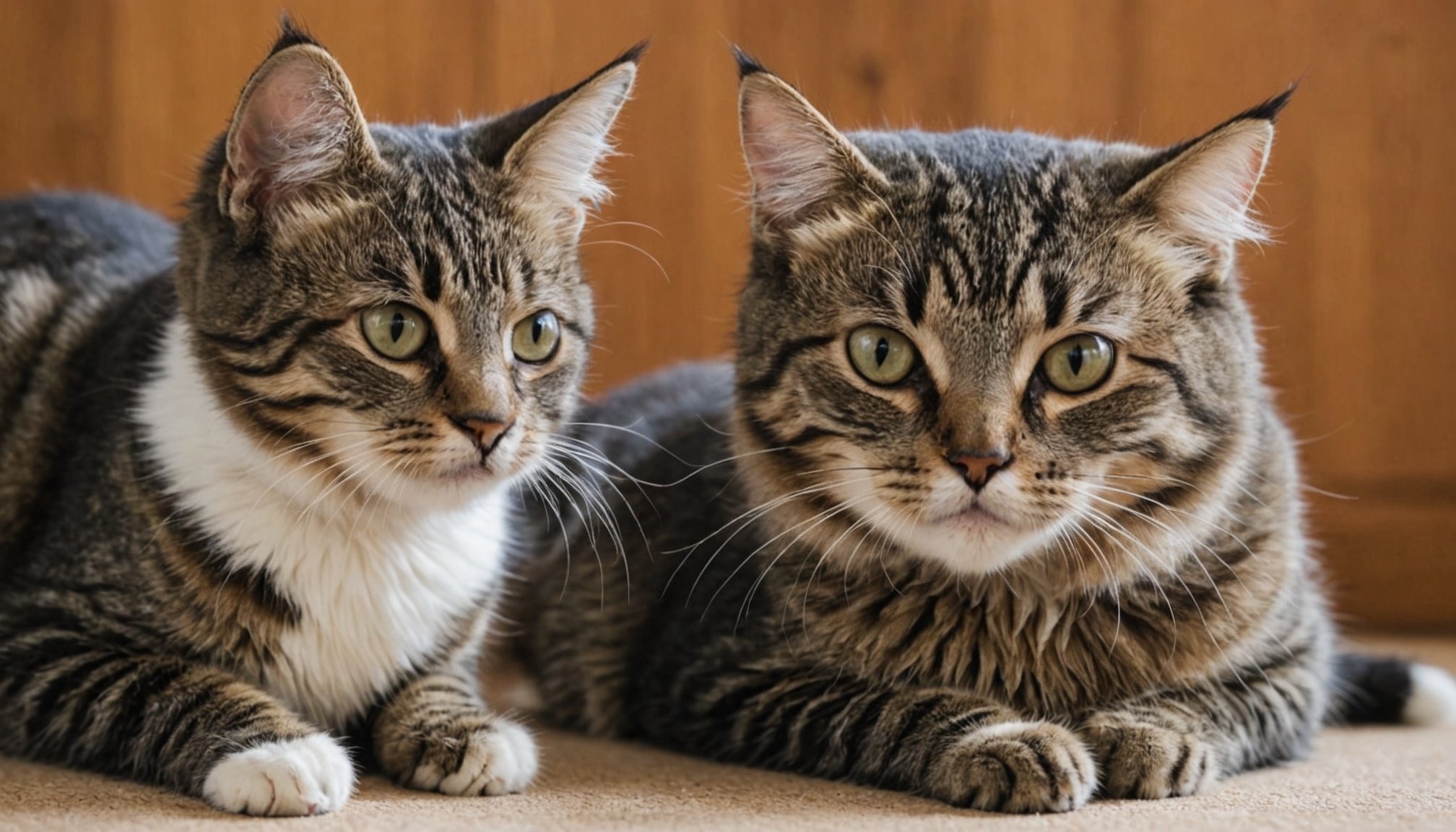Understanding Cat Behavior
Understanding cat behavior is crucial when introducing a new kitten into your home, especially if you have senior cats. Senior cats often display specific behaviors that can influence their response to a new family member. They typically value routine and may exhibit signs of territoriality. It’s not uncommon for them to be less adaptable to change compared to kittens. Recognising these common behaviors can help manage successful introductions.
Kittens, on the other hand, are naturally energetic and inquisitive. Their playfulness and tendency to explore everything contrasts sharply with the calmer demeanor of senior cats. This difference in behavior can lead to misunderstandings between the two, as senior cats might feel overwhelmed by the kitten’s exuberance.
Also read : Create a serene sanctuary: designing the perfect calm space for your anxious cat at home
When introducing a new kitten to senior cats, it’s important to watch for signs of stress in both parties. Stress indicators can include hiding, hissing, or changes in eating habits. Understanding these signs enables you to intervene swiftly, ensuring both your senior cats and new kitten remain comfortable during the transition. A structured introduction process promotes harmony and reduces the likelihood of conflict, giving each cat—whether senior or a kitten—the opportunity to adjust to their new environment at their own pace.
Preparing for the Introduction
Setting up the environment for a new kitten requires careful preparation to ensure a seamless integration with your existing senior cat. Establishing a designated safe space for the kitten is crucial. This area should be a quiet room where the kitten can acclimatise without disturbance. Here, essential items like a litter box, bedding, and toys should be readily accessible, ensuring the kitten feels comfortable and secure.
Also read : Ultimate guide to providing exceptional care for cats with feline lower urinary tract disease (flutd)
For the senior cat, it’s vital to maintain their sense of security in their established environment. Make sure that they have access to their favourite spots and familiar objects, allowing them to feel in control of their territory. This can help mitigate anxiety, which is common when introducing a newcomer to the home.
The gradual introduction technique involves brief supervised visits between the kitten and the senior cat. Start by introducing their scents through toys or blankets before enabling physical interaction. This helps both cats to slowly adjust to each other’s presence and reduces potential stress or conflicts. Gradual introductions ensure that neither pet feels overwhelmed, fostering a peaceful cohabitation in the long run.
Step-by-Step Introduction Process
Setting the stage for a harmonious relationship between new and existing cats involves a meticulously structured introduction process. This begins with the essential practice of scent swapping. This method allows each cat to gradually become accustomed to the other’s scent, easing initial apprehensions. You can achieve this by exchanging bedding or items the cats frequently use. Such familiarization is crucial as it sets the foundation for future interaction, reducing stress and potential aggression.
Initial Scent Swapping
Scent swapping should be your first step. It’s a non-intrusive method allowing cats to explore new scents at their own pace, setting the stage for controlled visual introductions.
Controlled Visual Introductions
Once both cats show comfort through scent recognition, proceed to visual introductions. Utilise gates or barriers that allow eye contact without direct interaction. This technique maintains a controlled environment, minimising anxiety and enabling the cats to gradually adapt to each other’s presence safely.
Supervised Interactions
The final step involves supervised visits. During these interactions, closely monitor both cats’ behaviours to ensure a positive experience. Gradual progression through these steps is paramount to fostering a successful relationship, encouraging understanding while preserving each cat’s comfort.
Addressing Potential Challenges
Navigating the integration of a new pet involves recognizing and addressing common challenges, such as signs of aggression or fear. An essential skill is identifying these aggression signs in senior cats, which may include hissing, swatting, or fluffing their fur. Understanding these indicators early can make a world of difference in ensuring a smoother adjustment period for both the feline residents and newcomers.
Behavioral issues such as territorial behaviour are frequently observed when a new pet enters an established domain. Senior cats, in particular, are known for asserting dominance in their space. Strategies to manage this behaviour can involve creating liberating zones for each pet. This separation allows the senior cat to retreat to a familiar area when they feel anxious or over-stimulated, promoting a sense of security.
Patience and flexibility are key virtues during this process. Progress may seem slow at times, but maintaining a structured approach without rushing interactions can encourage a more harmonious cohabitation. Being vigilant to both the senior cat’s and the newcomer’s non-verbal cues is crucial. Adjustments to the introduction strategy should be made as needed, always prioritising the comfort of all pets involved.
Monitoring Interaction and Adjustment
Monitoring the interaction between cats requires careful attention and keen observation. Behavioral observations provide insight into how cats are responding to each other during their adjustment period. Look for positive signs, such as playing or sitting together, as well as negative cues, including hissing or territorial gestures. It is essential to identify behaviors that indicate comfort or stress, allowing you to adjust your approach accordingly.
Signs that suggest the need to slow down or reassess the introduction include persistent aggression, excessive hiding, or extreme vocalization. Such behaviors indicate that the cats may not be ready for closer contact. In these cases, it is often beneficial to provide separate spaces for each cat and gradually reintroduce them with supervised sessions.
Ongoing adjustments are crucial, as individual cat responses can vary greatly. Continuously monitoring their interactions will help ensure the safety and comfort of all parties involved. Effective observation can also prevent potential conflicts, making the adjustment period smoother. Maintaining patience and adaptability during this process aids in fostering harmonious relationships between your feline companions.
Enhancing Emotional Well-Being
Introducing a new kitten to a senior cat can be a delicate process. Emotional health is crucial for both cats, fostering a harmonious cohabitation. Bonding between a senior cat and a kitten can be encouraged by creating a safe space where they feel comfortable and secure. Start by introducing their scents to each other through blankets or toys, avoiding direct contact initially.
Positive reinforcement plays a significant role in this transition. Reward both cats with treats or affection when they display calm behavior towards each other. This encourages them to associate their interactions with positive outcomes.
Ensure that both cats receive attention and care, addressing each one’s specific needs. A senior cat may need more quiet time, while a kitten might require more playtime to expend energy. By dividing your time thoughtfully and maintaining their routine, you mitigate jealousy and anxiety.
Presenting feeding times and spaces where both feel safe can further fortify their sense of security. Gradually allow them to share supervised play, increasing the duration as their comfort grows. Remember, patience and positive reinforcement are key in nurturing an emotional bond, ultimately enhancing their emotional health during this transition.
Preparing Your Home for the New Kitten
Welcoming a new kitten into your home requires thoughtful preparation, especially when a senior cat is already part of the household. To ensure harmony and reduce stress, it’s beneficial to establish separate spaces for each feline. This division helps your senior cat adjust without feeling overwhelmed by the newcomer. Setting up a unique feline environment is crucial for both cats’ comfort.
Begin by designating individual areas stocked with essential supplies like litter boxes, food bowls, and scratching posts. It’s important that these items are placed separately for each cat, minimizing territorial disputes. For a smooth transition, create cozy zones where both can retreat and feel secure.
Safety is a top priority when preparing your home for kittens. Check for potential hazards such as electric cords, small objects, or any toxic plants that may pose risks. A safe space alleviates anxiety, contributing to a stress-free environment for your new kitten and your senior cat. Introduce them gradually, allowing time for each to adapt, ultimately leading to a peaceful coexistence.
By focusing on individual needs and creating a nurturing setup, you foster an environment conducive to each cat’s well-being.
Choosing the Right Time for Introduction
Successfully introducing a new pet to a household requires careful consideration of timing. It’s important to recognise the optimal period for introducing a kitten to your existing senior cat. Monitor the senior cat’s behaviour closely, as this is often indicative of their mood and readiness. Signs such as increased curiosity or calm behaviour may signal they are amenable to the introduction of a new pet.
Timing is crucial. Ideally, plan introductions when there aren’t significant changes or stressors in your home, like renovations or holidays. These events can elevate stress levels, making your senior cat less receptive.
Understanding your kitten’s readiness is also essential. Ensure the kitten is comfortable in its surroundings and has had adequate time to adapt before meeting the senior cat. This includes being litter trained and familiar with basic routines within the house.
Whenever possible, maintain a consistent environment and schedule, as cats thrive on routine. By ensuring both the senior cat and the kitten are ready and stress-free, the introduction is more likely to be successful and harmonious for all involved.
The Gradual Introduction Process
Introducing a new cat to your household can be both exciting and daunting. Using careful gradual introduction techniques ensures a smoother transition and helps in building feline relationships. Understanding and observing cat behavior during this time is crucial for success.
Initial Separation
Begin by maintaining an initial separation between the new cat and existing pets. This allows each feline to acclimate to the other’s presence without direct contact. It curbs potential turf disputes and minimises stress, giving you a chance to observe your cats’ behaviour from a safe distance.
Scent Exchange Techniques
Before any visual meetings, perform a scent exchange. Swap bedding or toys between the cats to let them get accustomed to each other’s smell. This practice fosters a sense of familiarity, easing stress and anxiety. It’s a subtle yet effective step in building rapport between future feline pals.
Controlled Meetings
Prepare for the first meeting by first allowing the cats to sniff at a closed door, reinforcing their prior scent introduction. Schedule short, supervised meetings to observe their reactions carefully. Ensure that these interactions are controlled and limited initially. Gradually increase the interaction time while consistently monitoring their behaviour to ensure they remain comfortable with each other’s presence.
Monitoring Behavior During the Transition
Transitioning for cats requires careful behavior monitoring to ensure a smooth adjustment. Being attentive to feline body language and vocalizations is crucial. Cats often communicate their stress or discomfort through these non-verbal cues. Noticing behaviors such as excessive hiding, growling, or a rigid body posture can indicate stress. It’s important to observe interactions between both cats, as this can help identify any signs of aggression or territorial disputes which might require intervention.
To promote stress reduction for cats, ensure they have safe spaces to retreat to if necessary. Having distinct areas where each cat can rest undisturbed can ease tension. Also, consider using calming aids. Products like pheromone diffusers or sprays can create a more relaxing environment, thus easing the transition.
Identifying and understanding the signs of adjustment are key to facilitating a smooth integration. These signs can be subtle, such as a reduction in hostile vocalizations or visible relaxation upon their interaction. Monitor daily behaviors to ensure any change is positive and supportive of healthy development. By focusing on these elements, successful integration is more achievable, leading to a harmonious living arrangement for both cats.
Managing Conflicts and Challenges
Navigating conflicts between senior cats and kittens can be tricky. Common sources of conflict stem from territorial disputes, where older cats may feel threatened by the presence of a new, playful kitten. Additionally, differences in energy levels can lead to misunderstandings and potential aggression. Understanding these triggers is key to effective conflict resolution for cats.
To foster harmony, consider implementing distraction techniques. Introduce toys and interactive play to channel the kitten’s energy away from the older cat. This can help diffuse tension and encourage positive interactions. Additionally, creating separate spaces for each cat can provide peace and allow them to retreat when feeling overwhelmed.
Sometimes, behavioral conflicts require more advanced interventions. If persistent issues arise, consulting a veterinarian or animal behaviorist is advisable. These professionals can offer tailored advice specific to your cats’ needs, ensuring a feline behavior management strategy that works in your home environment.
Finally, it’s essential to monitor the interactions carefully. Small adjustments in environment and routine can make a significant difference. Remember, establishing peace and mutual understanding between cats takes time and patience, but the rewards of a harmonious home are well worth the effort.
Building a Positive Relationship Over Time
To encourage relationship building between cats, it’s essential to have joint play sessions. These sessions not only help in feline socialization but also allow the cats to bond while engaging in enjoyable activities. Use a variety of toys to keep the environment stimulating and cater to the interests of each cat involved.
Positive reinforcement plays a crucial role in nurturing good behavior between your cats. During interactions, offer treats as rewards to reinforce peaceful coexistence and cooperation. This approach not only promotes understanding but also teaches the cats that good behavior leads to positive outcomes.
Establishing a consistent routine contributes significantly to the sense of security and familiarity among cats. When they know what to expect, they are likely to feel more comfortable and safe in their shared environment. Regular feeding times, designated playtimes, and shared resting areas can help your cats develop a stable relationship filled with trust.
By focusing on these aspects, you can ensure your cats thrive together, fostering a harmonious living situation that benefits both you and your feline companions.
Understanding the Long-term Dynamics
Developing long-term cat relationships involves navigating an initial adaptation period. Typically, cats may require several weeks to a few months to adjust to a new living situation. During this time, it’s crucial to observe and monitor feline interactions carefully. Recognising the natural behaviour of each cat helps identify whether their dynamic is amicable or requires intervention.
As the adaptation period for pets progresses, it’s essential to provide a stable environment that supports gradual adjustment. This involves maintaining routines and ensuring each cat has access to personal space. Regular observations will help in identifying any negative interactions that may arise. If tensions are detected, adjustments, such as reintroducing scent swapping or supervised meetings, might be necessary.
However, it’s important to acknowledge that some differences between cats may persist. This does not necessarily imply hostility. Instead, it reflects the distinct personalities and preferences each cat brings into the relationship. By continuing to create a supportive environment, ensuring individual needs are met, and allowing cats to express their natural behaviour, caretakers can facilitate a harmonious long-term coexistence. Understanding these dynamics fosters empathy and patience for the journey of blending feline family members.











